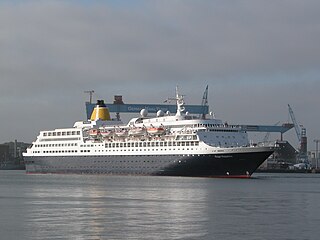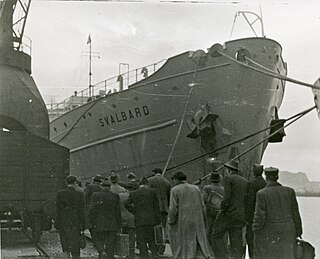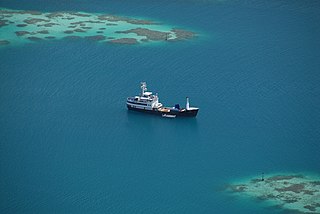 W
WBlue Sapphire is a cruise ship owned and operated by ANEX Tour. She was originally built in 1981 by Bremer Vulkan of Germany for Hapag-Lloyd Cruises as Europa. In 1999, Europa was sold to Star Cruises and she was renamed SuperStar Europe and a year later, Superstar Aries. In 2004, she was sold to Pullmantur Cruises and renamed Holiday Dream. In May 2008, she was transferred to the fleet of CDF Croisières de France and renamed Bleu de France. In November 2010, she was sold to Saga Cruises, but retained on charter by CDF for a further 12 months. Following an extensive refit in Italy from November 2011 to March 2012, the vessel was renamed Saga Sapphire. Most recently, she was sold to ANEX Tour in June 2020 and renamed Blue Sapphire, scheduled for an official debut in 2021.
 W
WMV Doulos Phos is a retired cruise ship that held the record of being the world's oldest active ocean-faring passenger ship, serving from 1914 until December 2009. She is now owned by Eric Saw, director and chief executive of BizNaz Resources International Pte Ltd in Singapore. She was previously operated by the German charity Gute Bücher für Alle, and was used as a floating bookshop. The ship has previously been known as the SS Medina, the SS Roma, the MS Franca C, and the MV Doulos. The Doulos ended her final cruise in late 2009 at Singapore, with the ship being handed over to her new owners on 18 March 2010. The ship underwent a three year conversion into a luxury hotel that opened in June of 2019.
 W
WEleni was a 6,112 GRT cargo ship that was built in 1947 by Lübecker Flenderwerke AG, Lübeck, Germany. She had been laid down as Greifswald for Norddeutscher Lloyd. She was captured uncompleted in May 1945 and passed to the Ministry of War Transport (MoWT), being completed in 1948 as Empire Ely. In 1954, she was sold to a Liberian company and renamed Maribella. A sale in 1955 to West Germany saw her renamed Ganges. In 1959, she was sold to Greece and renamed Eleni, serving until she was involved in a collision in 1971. She was declared to be beyond economic and scrapped in April 1972.
 W
WFairwood was a Hansa A Type cargo ship which was built as Celia in 1943 by Lübecker Maschinenbau-Gesellschaft, Lübeck, Germany for A. Kirsten, Hamburg, Germany. She was seized as a prize of war in 1945, passing to the Ministry of War Transport and renamed Empire Gallant. She was sold in 1947 and was renamed Richard Borchard. She was sold in 1960 to West Germany and was renamed Fairwood. She served until 1963 when she was scrapped.
 W
WJustinian was a 1,875 GRT cargo ship that was built in 1940 by Nobiskrug Werft, Rendsburg for a Norwegian owner. She was seized on completion, renamed Karl Christian Lohse and used by a German company. She was seized by the Allies in May 1945 at Flensburg, passed to the Ministry of War Transport (MoWT) and renamed Empire Conningbeg.
 W
WMi Amigo was originally a three-masted cargo schooner, that later gained international recognition as an offshore radio station. She was built as the schooner Margarethe for German owners. A sale in 1927 saw her renamed Olga and she was lengthened in 1936. During the Second World War, she was requisitioned by the Kriegsmarine and served as an auxiliary ship between 1941 and 1943. In 1953, the ship was again lengthened to 133 feet 9 inches (40.77 m). In 1959, she was sold for conversion to a floating radio station and was renamed Bon Jour. Subsequently, she was renamed Magda Maria in 1961 and Mi Amigo in 1962. She served, intermittently, as a radio ship, until 1980, when she sank in a gale.
 W
WOtto Hahn was one of only four nuclear-powered cargo vessels built to date. Planning of a German-built trade and research vessel to test the feasibility of nuclear power in civil service began in 1960 under the supervision of the German physicist Erich Bagge. Launched in 1964, her nuclear reactor was deactivated fifteen years later in 1979 and replaced by a conventional Diesel engine room. The ship was scrapped in 2009.
 W
WPassat is a German four-masted steel barque and one of the Flying P-Liners, the famous sailing ships of the German shipping company F. Laeisz. She is one of the last surviving windjammers.
 W
WSS Pasteur was a steam turbine ocean liner built for Compagnie de Navigation Sud-Atlantique. She later sailed as Bremen for Norddeutscher Lloyd. In the course of her career, she sailed for 41 years under four names and six countries' flags.
 W
WSpeedlink Vanguard was a 3,514 GRT train ferry which was built in 1973 as Stena Shipper. She was charted to a New Zealand operator on completion and renamed Union Wellington and saw further service as Alpha Express and Stena Shipper before entering service with Sealink as Speedlink Vanguard. The ship was involved in a collision with European Gateway in 1982, which sank the latter ship with the loss of six lives.
 W
WSS St. Cergue was a Swiss cargo ship, originally the British merchant ship Felldene. She served in the Merchant Marine of Switzerland during the Second World War, notably rescuing survivors of several ships sunk by submarines.
 W
WStettin is a steam icebreaker built by the shipyard Stettiner Oderwerke in 1933. She was ordered by the Chamber of Commerce of Stettin. The economy of the city of Stettin strongly depended on the free access of ships to and from the Baltic Sea. Therefore, icebreakers were used to keep the shipping channels free from ice during the winter.
 W
WThekla is a former cargo ship moored in the Mud Dock area of Bristol's Floating Harbour, England. The ship was built in Germany in 1958 and worked in the coastal trades.
 W
WMS Togo was a German merchant ship that was launched in 1938. Requisitioned by Nazi Germany's Kriegsmarine as Schiff 14, in April 1940 she participated in the invasion of Norway; in August 1940 was converted to a minelayer as part of the German plan to invade England; then from June 1941 she began conversion to the armed auxiliary cruiser (Hilfskreuzer) HSK Coronel.
 W
WYWAM Koha is a New Zealand-registered Medical Aid Ship, built in 1968 as the buoy tender Konrad Meisel for the German Government and later owned in South Africa as Isibane. As the Claymore II she provided the essential transport links to the remote Pacific territory of Pitcairn Island from New Zealand and French Polynesia, part-funded by the British Government until 2018 when she was replaced by the Silver Supporter.